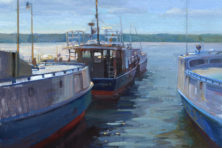Questions & Artists: Plein Air Painter Lori Beringer
- Share
- Tweet
- Pin
- Share

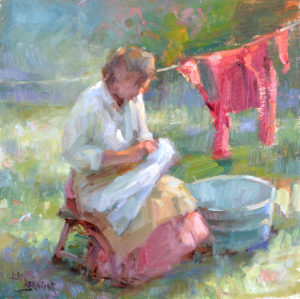
“Mend & Wash” by Lori Beringer.
This interview came about, as do most, in an interesting way. Rick Brawner and I were painting in the Plymouth, Wis. “Paint the Town” plein air event this fall. I had taken my paintings in and took a quick walk through the hanging area. One painting stood out and it was a beautiful work showing a lady with light bouncing off her shoulders just done wonderfully [“Mend & Wash,” right]. I was so taken with the painting I went back in twice to see it again. It was one of Lori’s paintings that ended up winning multiple awards. Rick went in after me and he, too, noticed the painting.
I met and talked to Lori that day, complimented her on her paintings and we decided to do a Q&A for the Pulse. She has won too many awards to list here but when you see her work you will know how accomplished she is. She understands light and something many painters never understand, the value of grays. We had several wonderful conversations and I think you will enjoy the interview. Her website is loriberinger.com.
Randy Rasmussen (RR): Lori, I want to thank you for participating in this Q & A. The readers enjoy learning what it is like to be a working artist.
Lori Beringer (LB): I think we all want to be working and creating everyday. The reality isn’t as romantic. Life happens to us all. Artists today have the additional tasks of social media, website maintenance, answering emails. For me the distraction can be deafening. When I am painting I try to turn off the noise and immerse myself into the now. It was glorious to really see, hear, smell, feel the woods I painted last week. Then, back to the computer, phone calls, teaching. This is rewarding as well. But, without the creating in the moment I wouldn’t be me. All of our life experiences get into our work. I painted some gray paintings during the Plymouth “Paint the Town” plein air competition. I had to express my sadness over the politics in our great nation. But, in the gray I painted hope. “Up” won best of show. I think the judge felt the tension with the spark of glimmering sky that held the painting composition together. I am not alone in the journey to create. I ask what, how, why continually. Inspiration is in the seeing and living. Each journey at the easel is a spiritual experience. Sometimes it’s a struggle that puts me in a position to submit to the perfect creator.
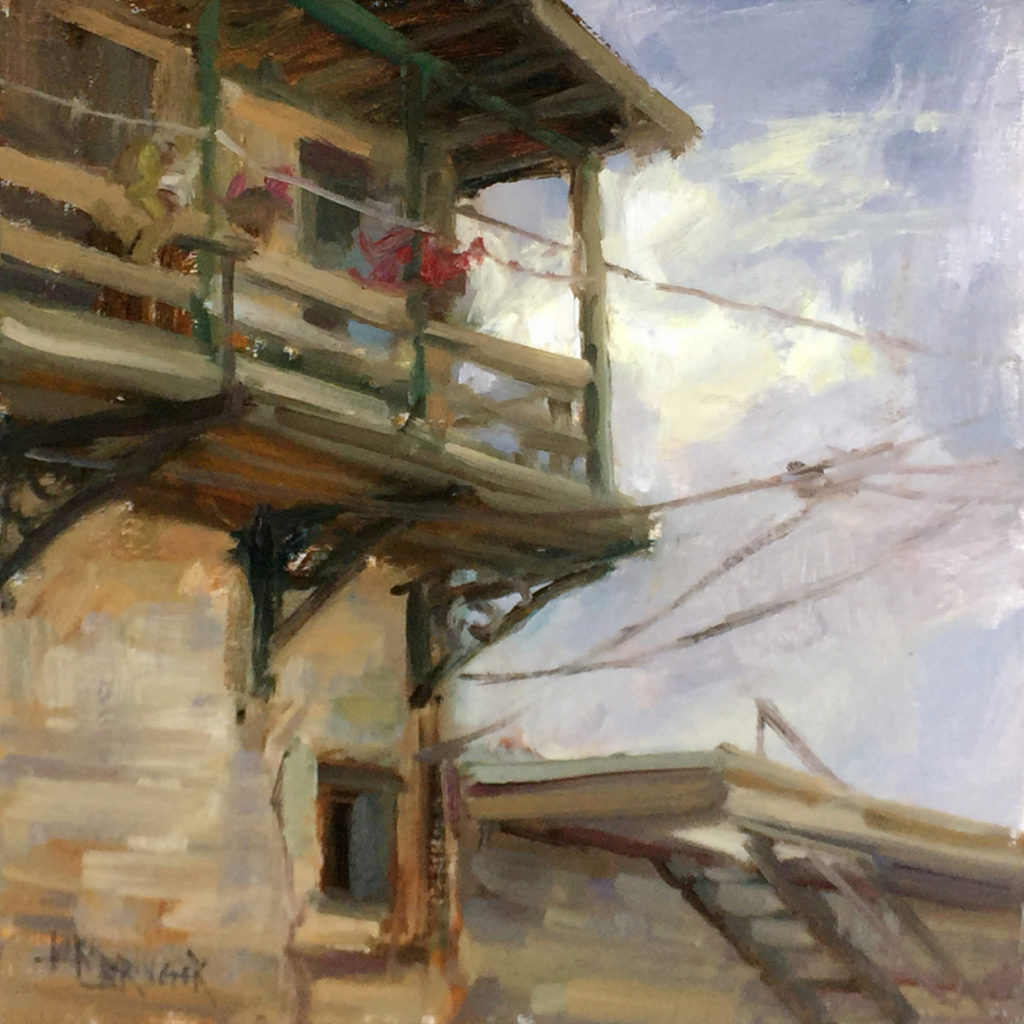
“Up” by Lori Beringer.
RR: We met and discussed this interview at the “Paint the Town” plein air event in Plymouth, Wis. earlier this year. You live in the area and I think it was a wonderful place to paint. Do you have a favorite subject to paint in the Plymouth area?
LB: Anything that feels honest. I am most often attracted to architecture, people, animals rather than a pure landscape. Buildings look like people to me. They have character with a story. Often a window is winking and a door’s lips pursed. I see the family story in buildings and their relationships.
RR: Do you remember when you realized how much you liked art?
LB: My earliest memories are of family, light, shadow and color. My grandmother’s response to my question, “Is this a memory or a dream?” I described the scene vividly. “You can’t remember that!” I was three years old. The light and shadow danced with brilliant colors across the grass and picnic blanket during grandpa’s surprise party. I still love shadows with sunspots. My family tells me I sketched everyday, filling up my dad’s salesmen tablets. In school during study hall my friends were sketched often. I always knew creating art would be my passion. And it gets better with age. My work is more of a journal of where, when and how I felt. My toolbox is still gaining new tools, often using old ones in a new way.
RR: I have been doing artist interviews for almost eight years. It always starts with drawing, doesn’t it?
LB: Drawing is our outward way to problem solve. Artists do this because they have to. Recently I have been playing with pastels. As a painter I draw with paint briefly then start to block in large shapes quickly. I miss line. Playing with different mediums is a good way to explore and feel free to find new ways to express myself. One medium feeds another.
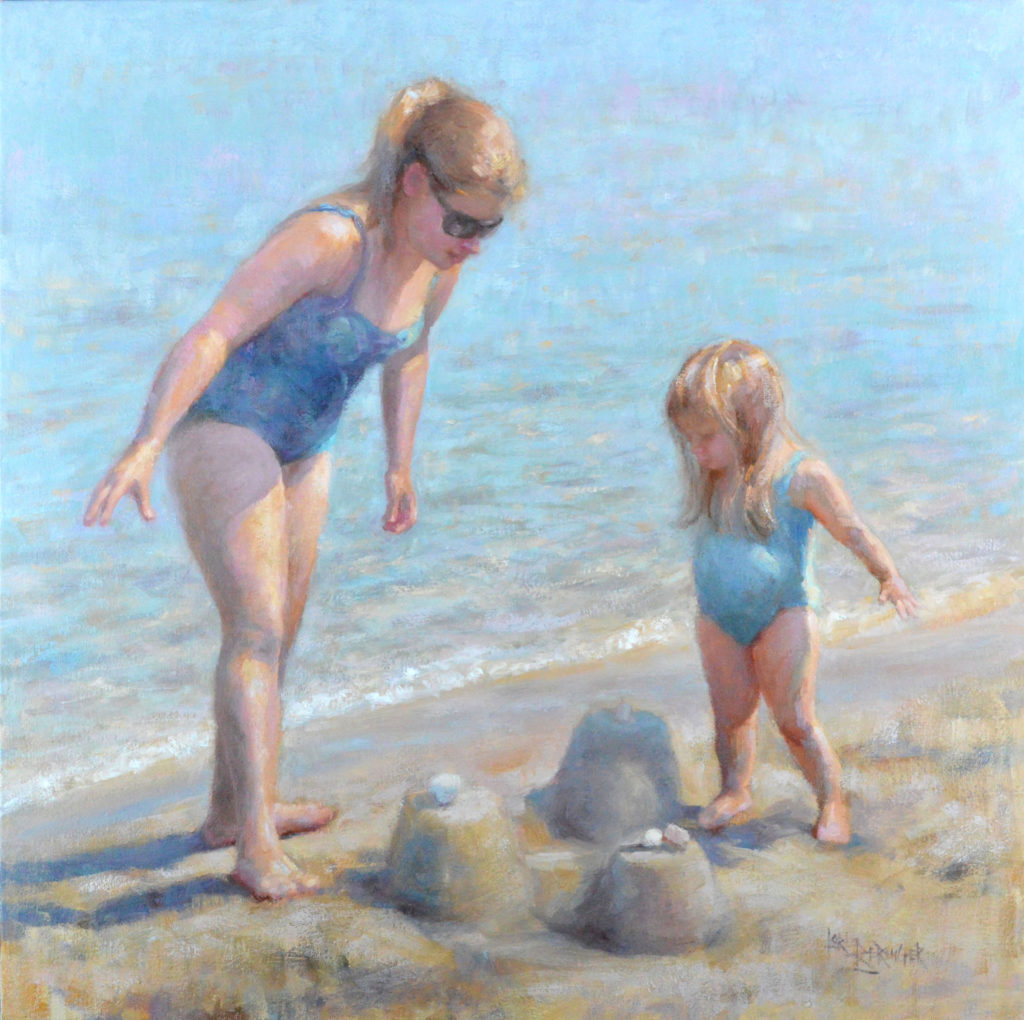
“We Did It” by Lori Beringer.
RR: I know you have one of the David Curtis books about light. How important is it in your opinion to see the “light?”
LB: Before I paint, these questions need answers: What temperature is the light? Is it a cloudy or sunny day? The color of the light influences everything it touches. I am constantly asking myself how dark, how light, how warm, how cool is this shape compared to the others.
RR: Have you added any colors to your palette recently?
LB: Utrecht Brilliant Blue. It’s a balance between Phthalo blue and Ultramarine blue. I’ll tell you a secret. A good quality paint in a dark blue, dark red and yellow plus white will get you started. The secret to good color is time spent mixing from life. A smaller palette will teach a good foundation of what is in a color mixture. From there add more pigments to gain a more complicated understanding.
RR: I find your statement, “One can’t appreciate color without the grays” profound. In my opinion, that almost says it all.
LB: Comparison is the key. We cannot see light without dark. Warm colors look warmer next to cool colors. Soft edges look softer with a sharp contrast to judge it against. An orange tree ablaze in color looks more orange against the blue sky complement. Equal saturation will vibrate the colors. A painting full of saturated color would be difficult for your eye to look at and appreciate that it’s colorful. Here is where a grayed down color works its magic. A grayed down blue will help your eye see the color around it. The orange tree pops off the canvas because there is less competition.
RR: Do you use a “stock” warm gray and cool gray or do you mix the grays depending on what you have?
LB: My palette is limited. Grays can be mixed easily by using what is on your palette during your painting session. For instance, if I have green and violet on the palette I can take paint from both of these puddles and mix them together. I have choices. I can blend the gray to a violet gray or a green gray. Equal amounts will create a brownish muddy mixture. Another benefit to using what is already mixed on your palette is repeating color. This will create more harmony throughout the work.
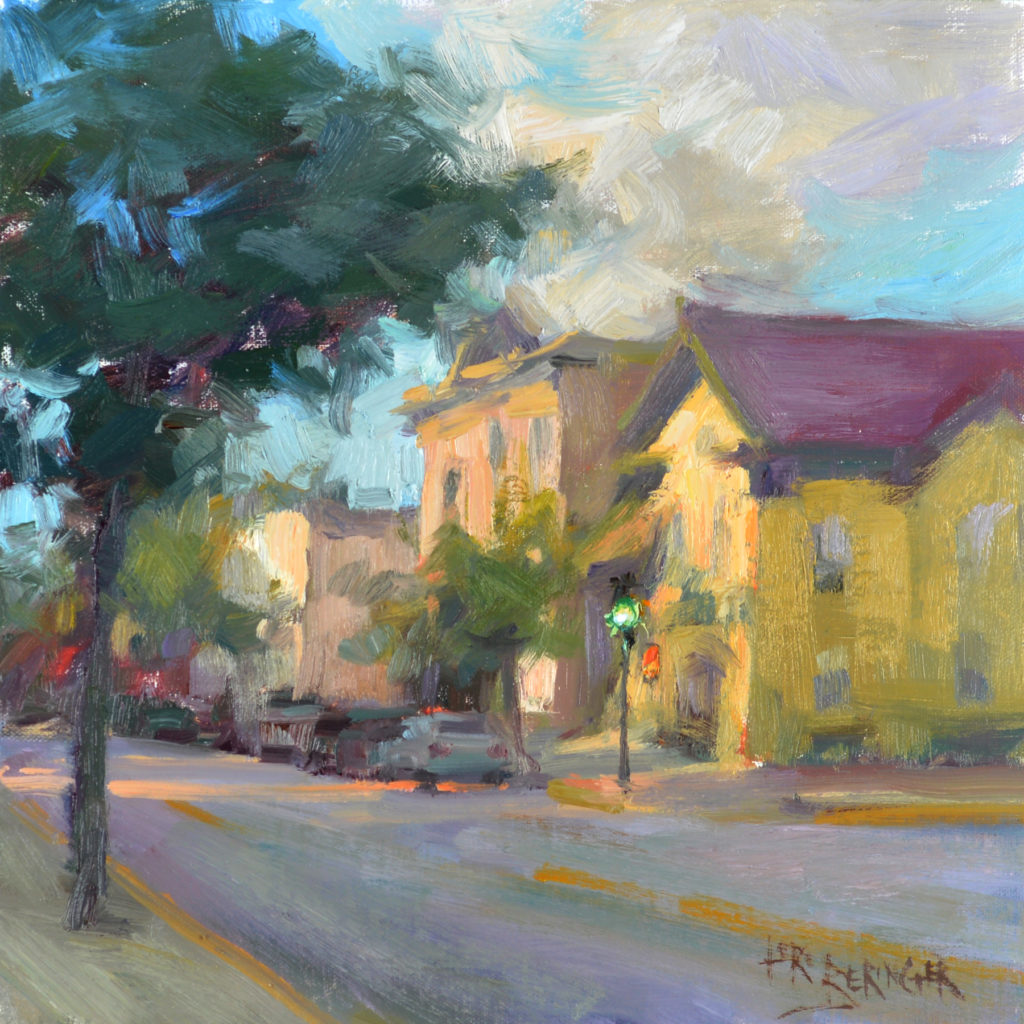
“Warm Welcome” by Lori Beringer.
RR: How would you describe your work?
LB: I strive for a feeling of light and honesty. If I paint how I feel as honest as I can then the work has a tangible emotion the viewer will feel. That emotion can be seen in my brushwork and by the color I get excited about. My hope is for the work to be strong from 10 feet away. Something you would notice from across the room. I love it when a viewer comes closer and is a bit confused by what they expect to see. They are expecting fine detail. I like to leave that out for the viewer to fill in and participate in.
RR: Do you have a favorite place to paint in Door County?
LB: Places that show their imperfection, like a woman before her face is made up. A building or boat that needs a little work feels more honest and vulnerable to me. The scene is showing tenderness, loneliness, joy, bearing it all, so to speak. So, any place with a bit of the human influence. I also love painting at the beaches! Everything about the beach with children old and young draws me in. The sounds: waves, wind, laughter. It is a happy place and families have been very generous in sharing their views and stories.
RR: Who are your favorite painters and why?
LB: Nicolai Fechin for his abstraction. His takes the form as far as possible before losing shapes, at times adding exquisite line. His model’s hands are the most expressive and beautiful of any painters. Joaquín Sorolla painted the light and color temperature shifts brilliantly. His shapes appear to shimmer full of life. Edgar Payne’s landscape designs with figures are powerful and full of emotion. John Singer Sargent’s portraits are stirring with depth. The atmosphere is tangible in all his work. You can almost see the air move.
RR: Thank you.

